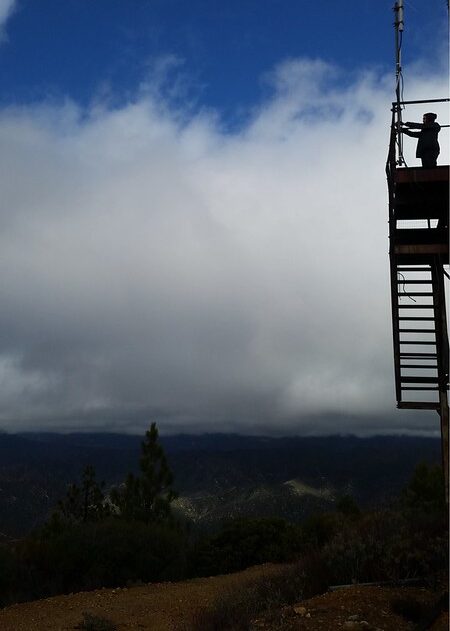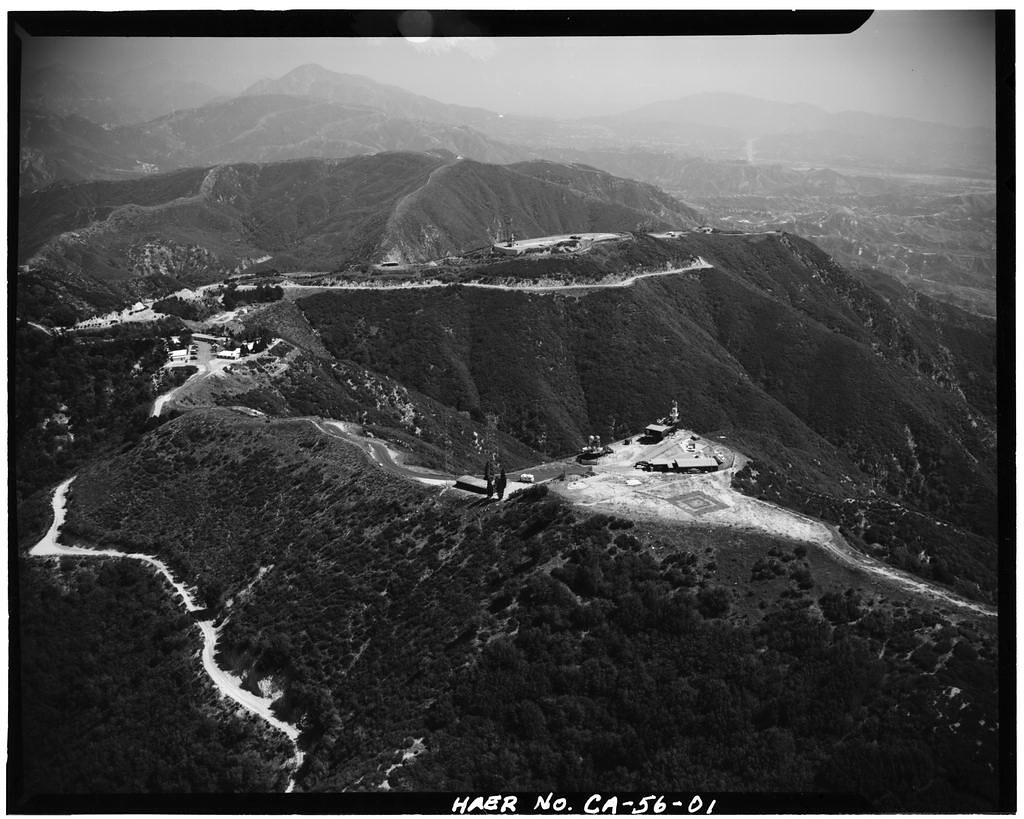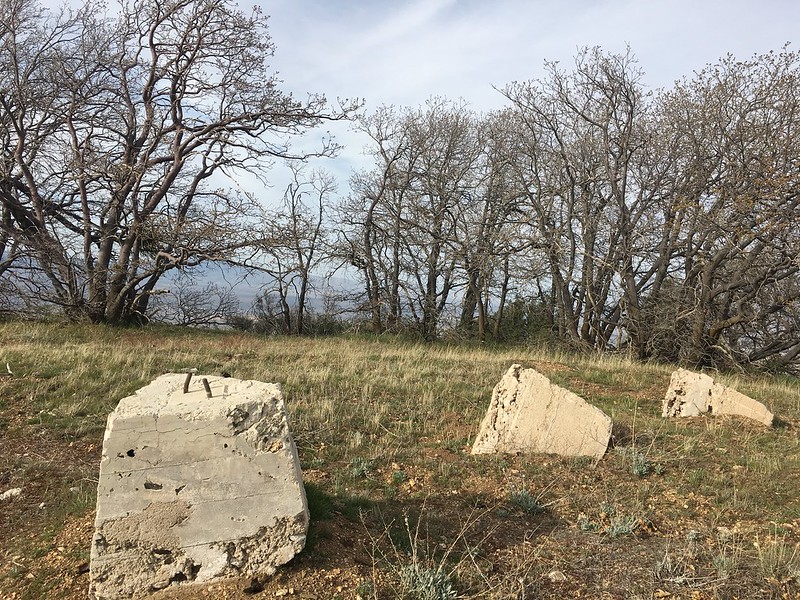Ross Field
Agency: US Army & US Forest Service
Dates: 1918 until 1919
Type: Observation balloons
Status: Demolished
Coordinates: 34.129444, -118.04
Trail reports: Forest Lookouts, Wiki Page on Ross Field, Military Museum, Abandoned & Little-Known Airfields
Military observation balloons were used for a brief period during World War I to aid in fire lookout service of the Angeles Forest.
 Ross Field, U.S. Army Balloon School, Aerial View Looking Northeast. Courtesy of Arcadia Public Library
Ross Field, U.S. Army Balloon School, Aerial View Looking Northeast. Courtesy of Arcadia Public Library
Opened in 1918, Ross Field was built to train U.S. Army balloon observation troops for World War I. Anita Baldwin donated the land to the government in order to construct the balloon school (the site was part of Lucky Baldwin’s old Santa Anita racetrack.) The US Army Air Service trained their troops there in balloon handling, aerial photography, map-making, panoramic perspectives, observations, surveillance of ground fire and in ground tactics.
The site of Ross Field is located southwest of the intersection of Santa Anita Avenue & Huntington Drive where the Arcadia County Park and Golf Course is now located.
 A balloon flies above the U. S. Army Balloon School at Ross Field, 1918. Credit: Smithsonian National Air and Space Museum
A balloon flies above the U. S. Army Balloon School at Ross Field, 1918. Credit: Smithsonian National Air and Space Museum
 A parachute jumper descends upon the U. S. Army Balloons School, 1919. Credit: Smithsonian National Air and Space Museum
A parachute jumper descends upon the U. S. Army Balloons School, 1919. Credit: Smithsonian National Air and Space Museum
 Ross Field, U.S. Army Balloon School Panoramic View with San Gabriel Mountains in the Background and Row of Army Vehicles. Courtesy of Arcadia Public Library
Ross Field, U.S. Army Balloon School Panoramic View with San Gabriel Mountains in the Background and Row of Army Vehicles. Courtesy of Arcadia Public Library
Mount Wilson
To aid the student cadets in their training at Ross Field, a camp was set up at the top of Mt. Wilson where a panoramic view of the country simulated the high altitude observations from a balloon. At Ross Field, the Santa Ana winds would disrupt how high the balloons could be flown and create handling issues. But at Mt. Wilson, the students could learn the fundamentals without the windy obstacles. With the far-reaching views, the cadets would spend the day studying the territory, making maps and observing simulated artillery fire from the field below.
 Aerial view from Mount Wilson of parachuters over Santa Anita Park, Arcadia. Image courtesy of the Huntington Library.
Aerial view from Mount Wilson of parachuters over Santa Anita Park, Arcadia. Image courtesy of the Huntington Library.
Lookout Service
 United States Army Balloon School at Ross Field–Readying Balloon for Flight. Courtesy of Arcadia Public Library
United States Army Balloon School at Ross Field–Readying Balloon for Flight. Courtesy of Arcadia Public Library
Patrolling of the Angeles National Forest by observation balloon commenced in June 1919, which was a cooperative effort between the army and forest service. A lookout observer on an anchored balloon was flown at an elevation between 1500 to 3000 feet. Working from 7 am to 2:30 each day, the observer had a commanding view of the country equipped with powerful field glasses and maps of the front country. A telephone wire ran from the observation balloon to the switchboard at the post headquarters where alerts would be transmitted to the Forest Service. The student observation camp stationed at Mt. Wilson also rendered lookout service by phone. A fire-fighting truck stood at the field, ready with ten soldiers in case of fire.
Soon, supervisor R. H. Charlton established a continuous day and night fire patrol of Angeles National Forest by both balloon and forest service. The night patrol of the forest was conducted by forest rangers in canyons and trails.
 United States Army Balloon School at Ross Field–Balloon Training. Courtesy of Arcadia Public Library
United States Army Balloon School at Ross Field–Balloon Training. Courtesy of Arcadia Public Library
 United States Army Balloon School at Ross Field-Balloon Panorama. Courtesy of Arcadia Public Library
United States Army Balloon School at Ross Field-Balloon Panorama. Courtesy of Arcadia Public Library
Success of Fire Spotting
Credit for detecting and extinguishing the first forest fire by the aerial fire department in California falls to the men at Ross Field, Arcadia, California, according to reports in the Washington, D.C. papers.
The fire was discovered by the lookout in the captive observation balloon at a height of 1,500 feet, who telephoned the location of the fire to the special fire truck maintained in readiness and manned by a number of enlisted men.
Just seven minutes elapsed from the discovery of the fire to the arrival of the truck and firefighters at the Lucky Baldwin Ranch at the foot of the Sierra Madre Mountains.
The balloon observer is furnished with complete mountain maps divided into numbered squares, a duplicate of which is in the office of the fire department director on the ground.”
– June 1919, Service bulletin by US Forest Service
The success of spotting fires during aerial patrol proved so great that the forest service wanted to make an aviation school at the present location of the Ross Balloon Field. Rangers would be trained here in aviation and ballooning so that it would develop into a permanent part of forest fire-fighting.
 Credit: Monrovia Daily News, Jun 5, 1919
Credit: Monrovia Daily News, Jun 5, 1919
However, the forest service never secured the War Department’s approval for the plan, party because of lack of funds in the expense budget.
Decline of Ross Field
Following World War I, military balloons played a diminishing role in the Army while airplanes became reliable and advanced.
The city later sold the Ross Field property to the county to be redeveloped as the current Santa Anita Golf Course. A small historical plaque at the site commemorates its prior role.






